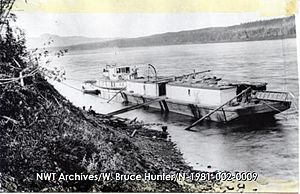Great Bear River facts for kids
Quick facts for kids Great Bear River |
|
|---|---|

Great Bear River exits Great Bear Lake near Deline
|
|
| Native name | Sahtúdé |
| Country | Canada |
| Physical characteristics | |
| Main source | Great Bear Lake, Northwest Territories, Canada 186 m (610 ft) 65°08′03″N 123°30′45″W / 65.13417°N 123.51250°W |
| River mouth | Mackenzie River Tulita, Northwest Territories, Canada 60 m (200 ft) 64°54′21″N 125°36′12″W / 64.90583°N 125.60333°W |
| Length | 113 km (70 mi) |
| Basin features | |
| Basin size | 156,500 km2 (60,400 sq mi) |
The Great Bear River is a river in the Northwest Territories of Canada. It flows for about 113-kilometre (70 mi) (70 miles) from Great Bear Lake to the Mackenzie River. The river is an important waterway for about four months each year when it is not frozen.
The Great Bear River starts at the southwest part of Great Bear Lake. It flows through marshy areas before joining the Mackenzie River. The river channel is about 350-metre (1,150 ft) (1,150 feet) wide and has an average depth of 6 metres (20 ft) (20 feet).
The river's flow rate is not very high. This is because the area around the river does not get a lot of rain or snow. Even in the 1970s, more than 80% of the river would melt and become open water during warmer times.
The community of Tulita is located right where the Great Bear River meets the Mackenzie River.
What Are the Great Bear River's Tributaries?
A tributary is a smaller stream or river that flows into a larger river. The Great Bear River has several tributaries that feed into it. These smaller waterways help to supply water to the main river.
Here are some of the streams that flow into the Great Bear River:
- Porcupine River
- Rosalie Creek
- Stick Creek
- Wolverine Creek
- St. Charles Creek
- Brackett River
See also
 In Spanish: Gran río del Oso para niños
In Spanish: Gran río del Oso para niños


